maintenance schedule INFINITI QX50 2021 Owner's Manual
[x] Cancel search | Manufacturer: INFINITI, Model Year: 2021, Model line: QX50, Model: INFINITI QX50 2021Pages: 542, PDF Size: 3.51 MB
Page 2 of 542
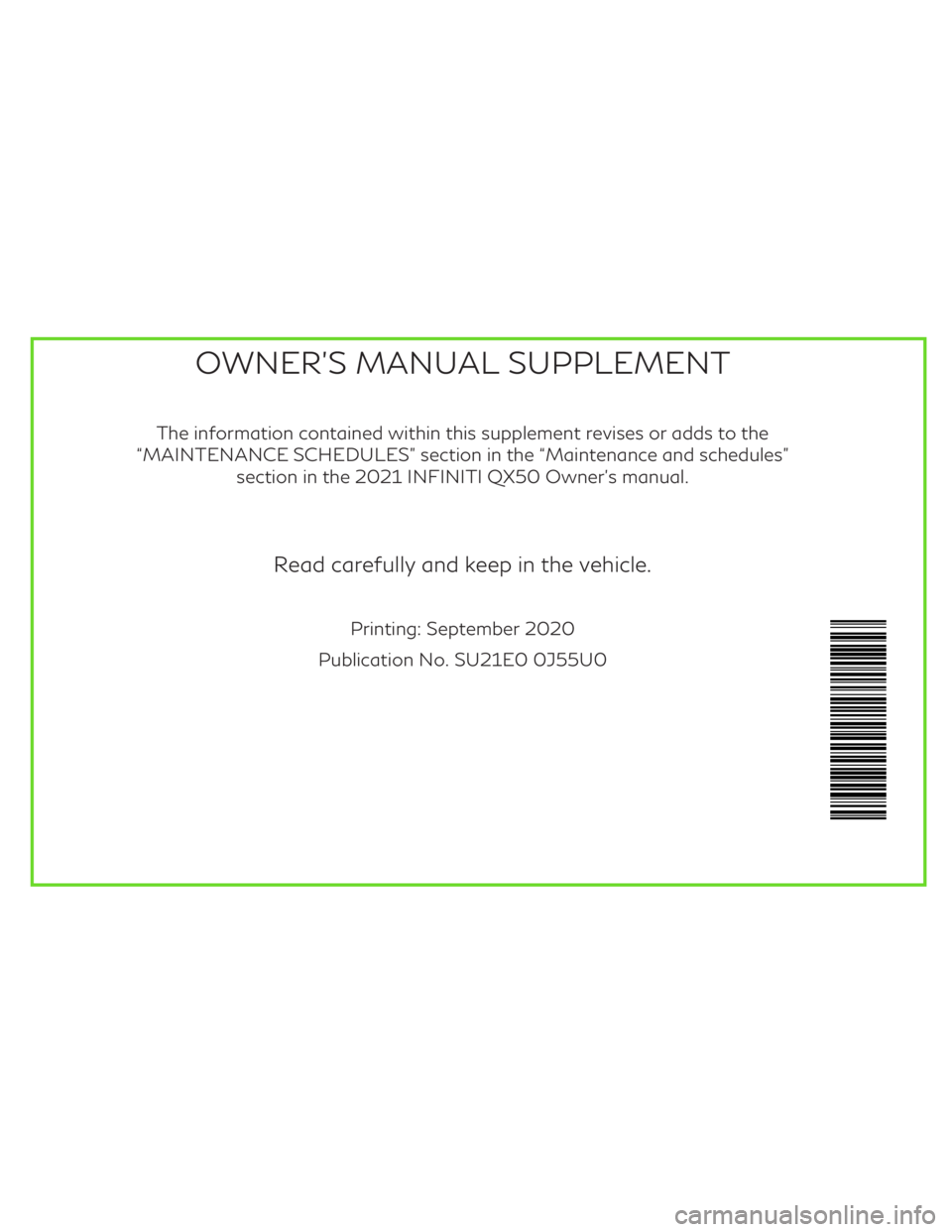
The information contained within this supplement revises or adds to the
“MAINTENANCE SCHEDULES” section in the “Maintenance and schedules”
section in the 2021 INFINITI QX50 Owner’s manual.
Read carefully and keep in the vehicle.
Printing: September 2020
Publication No. SU21E0 0J55U0
OWNER’S MANUAL SUPPLEMENT
Page 5 of 542
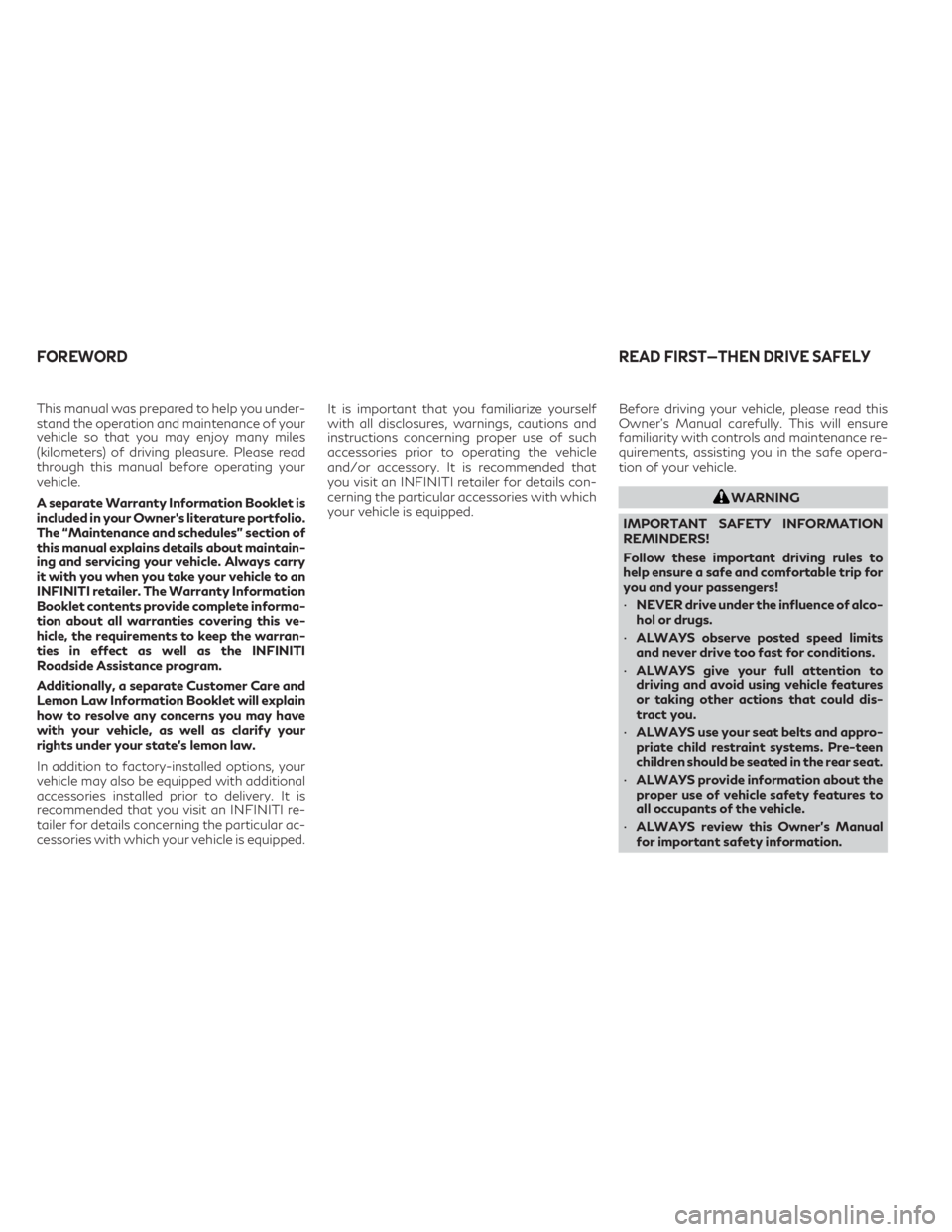
This manual was prepared to help you under-
stand the operation and maintenance of your
vehicle so that you may enjoy many miles
(kilometers) of driving pleasure. Please read
through this manual before operating your
vehicle.
A separate Warranty Information Booklet is
included in your Owner’s literature portfolio.
The “Maintenance and schedules” section of
this manual explains details about maintain-
ing and servicing your vehicle. Always carry
it with you when you take your vehicle to an
INFINITI retailer. The Warranty Information
Booklet contents provide complete informa-
tion about all warranties covering this ve-
hicle, the requirements to keep the warran-
ties in effect as well as the INFINITI
Roadside Assistance program.
Additionally, a separate Customer Care and
Lemon Law Information Booklet will explain
how to resolve any concerns you may have
with your vehicle, as well as clarify your
rights under your state’s lemon law.
In addition to factory-installed options, your
vehicle may also be equipped with additional
accessories installed prior to delivery. It is
recommended that you visit an INFINITI re-
tailer for details concerning the particular ac-
cessories with which your vehicle is equipped.It is important that you familiarize yourself
with all disclosures, warnings, cautions and
instructions concerning proper use of such
accessories prior to operating the vehicle
and/or accessory. It is recommended that
you visit an INFINITI retailer for details con-
cerning the particular accessories with which
your vehicle is equipped.
Before driving your vehicle, please read this
Owner's Manual carefully. This will ensure
familiarity with controls and maintenance re-
quirements, assisting you in the safe opera-
tion of your vehicle.
WARNING
IMPORTANT SAFETY INFORMATION
REMINDERS!
Follow these important driving rules to
help ensure a safe and comfortable trip for
you and your passengers!
• NEVER drive under the influence of alco-
hol or drugs.
• ALWAYS observe posted speed limits
and never drive too fast for conditions.
• ALWAYS give your full attention to
driving and avoid using vehicle features
or taking other actions that could dis-
tract you.
• ALWAYS use your seat belts and appro-
priate child restraint systems. Pre-teen
children should be seated in the rear seat.
• ALWAYS provide information about the
proper use of vehicle safety features to
all occupants of the vehicle.
• ALWAYS review this Owner’s Manual
for important safety information.
FOREWORD READ FIRST—THEN DRIVE SAFELY
Page 9 of 542
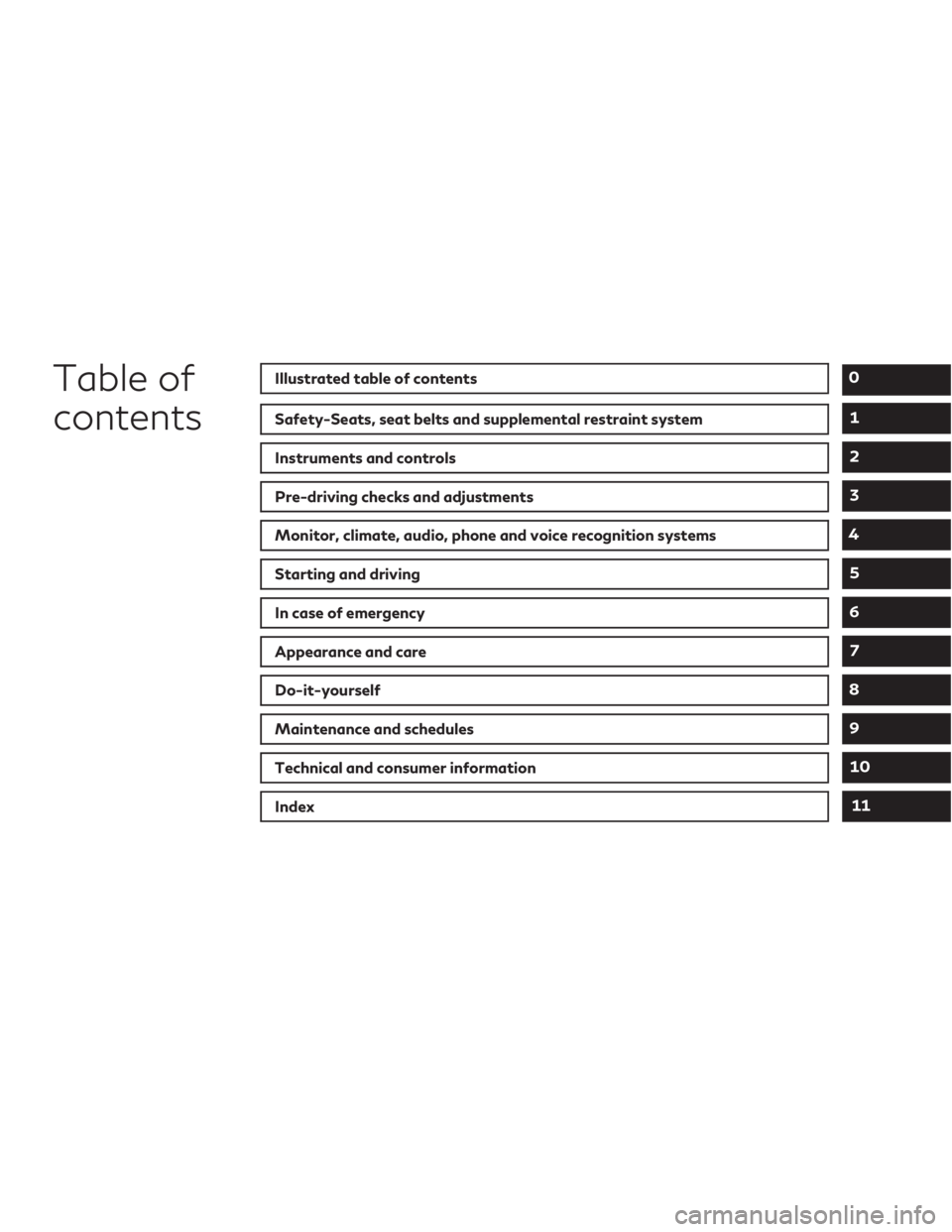
Table of
contentsIllustrated table of contents
Safety-Seats, seat belts and supplemental restraint system
Instruments and controls
Pre-driving checks and adjustments
Monitor, climate, audio, phone and voice recognition systems
Starting and driving
In case of emergency
Appearance and care
Do-it-yourself
Maintenance and schedules
Technical and consumer information
Index
0
1
2
3
4
5
6
7
8
9
10
11
Page 244 of 542
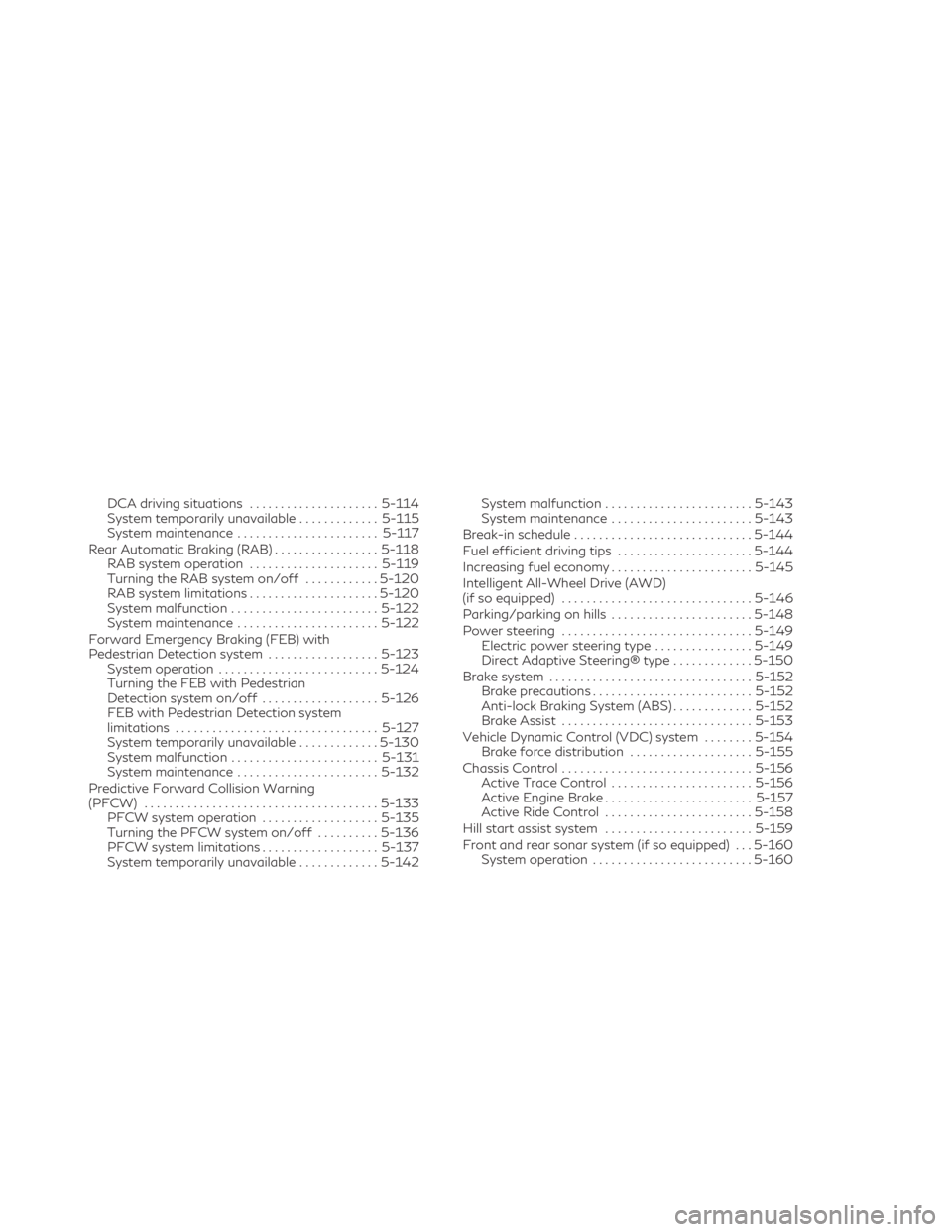
DCA driving situations.....................5-114
System temporarily unavailable .............5-115
System maintenance ....................... 5-117
Rear Automatic Braking (RAB) .................5-118
RAB system operation .....................5-119
Turning the RAB system on/off ............5-120
RAB system limitations .....................5-120
System malfunction ........................ 5-122
System maintenance ....................... 5-122
Forward Emergency Braking (FEB) with
Pedestrian Detection system ..................5-123
System operation .......................... 5-124
Turning the FEB with Pedestrian
Detection system on/off ...................5-126
FEB with Pedestrian Detection system
limitations ................................. 5-127
System temporarily unavailable .............5-130
System malfunction ........................ 5-131
System maintenance ....................... 5-132
Predictive Forward Collision Warning
(PFCW) ...................................... 5-133
PFCW system operation ...................5-135
Turning the PFCW system on/off ..........5-136
PFCW system limitations ...................5-137
System temporarily unavailable .............5-142 System malfunction
........................ 5-143
System maintenance ....................... 5-143
Break-in schedule ............................. 5-144
Fuel efficient driving tips ......................5-144
Increasing fuel economy .......................5-145
Intelligent All-Wheel Drive (AWD)
(if so equipped) ............................... 5-146
Parking/parking on hills .......................5-148
Power steering ............................... 5-149
Electric power steering type ................5-149
Direct Adaptive Steering® type .............5-150
Brake system ................................. 5-152
Brake precautions ..........................
5-152
Anti-lock
Braking System (ABS) .............5-152
Brake Assist ............................... 5-153
Vehicle Dynamic Control (VDC) system ........5-154
Brake force distribution ....................5-155
Chassis Control ............................... 5-156
Active Trace Control ....................... 5-156
Active Engine Brake ........................ 5-157
Active Ride Control ........................ 5-158
Hill start assist system ........................ 5-159
Front and rear sonar system (if so equipped) . . . 5-160 System operation .......................... 5-160
Page 387 of 542
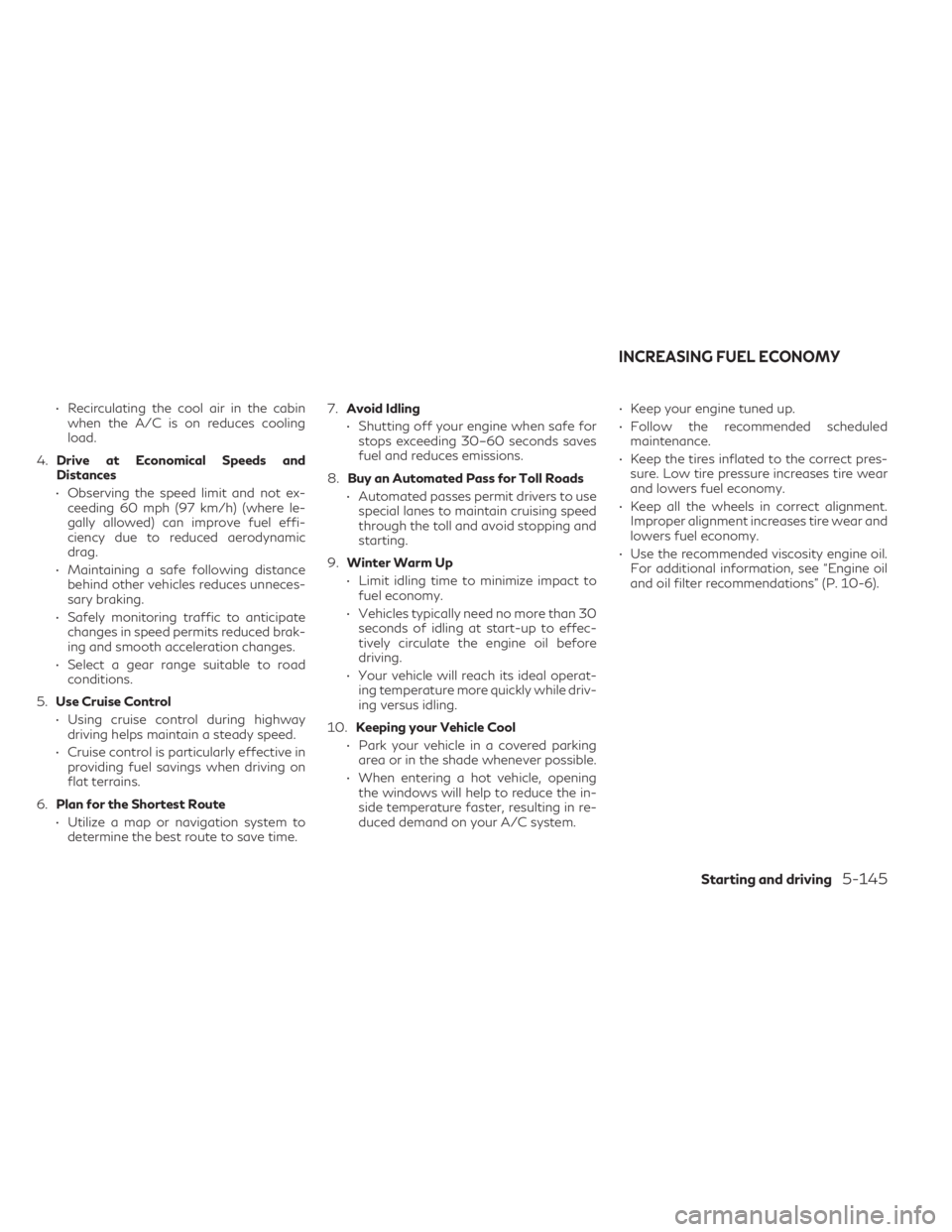
• Recirculating the cool air in the cabinwhen the A/C is on reduces cooling
load.
4. Drive at Economical Speeds and
Distances
• Observing the speed limit and not ex- ceeding 60 mph (97 km/h) (where le-
gally allowed) can improve fuel effi-
ciency due to reduced aerodynamic
drag.
• Maintaining a safe following distance behind other vehicles reduces unneces-
sary braking.
• Safely monitoring traffic to anticipate changes in speed permits reduced brak-
ing and smooth acceleration changes.
• Select a gear range suitable to road conditions.
5. Use Cruise Control
• Using cruise control during highway driving helps maintain a steady speed.
• Cruise control is particularly effective in providing fuel savings when driving on
flat terrains.
6. Plan for the Shortest Route
• Utilize a map or navigation system to determine the best route to save time. 7.
Avoid Idling
• Shutting off your engine when safe for stops exceeding 30–60 seconds saves
fuel and reduces emissions.
8. Buy an Automated Pass for Toll Roads
• Automated passes permit drivers to use special lanes to maintain cruising speed
through the toll and avoid stopping and
starting.
9. Winter Warm Up
• Limit idling time to minimize impact to fuel economy.
• Vehicles typically need no more than 30 seconds of idling at start-up to effec-
tively circulate the engine oil before
driving.
• Your vehicle will reach its ideal operat- ing temperature more quickly while driv-
ing versus idling.
10. Keeping your Vehicle Cool
• Park your vehicle in a covered parking area or in the shade whenever possible.
• When entering a hot vehicle, opening the windows will help to reduce the in-
side temperature faster, resulting in re-
duced demand on your A/C system. • Keep your engine tuned up.
• Follow the recommended scheduled
maintenance.
• Keep the tires inflated to the correct pres- sure. Low tire pressure increases tire wear
and lowers fuel economy.
• Keep all the wheels in correct alignment. Improper alignment increases tire wear and
lowers fuel economy.
• Use the recommended viscosity engine oil. For additional information, see “Engine oil
and oil filter recommendations” (P. 10-6).
INCREASING FUEL ECONOMY
Starting and driving5-145
Page 435 of 542
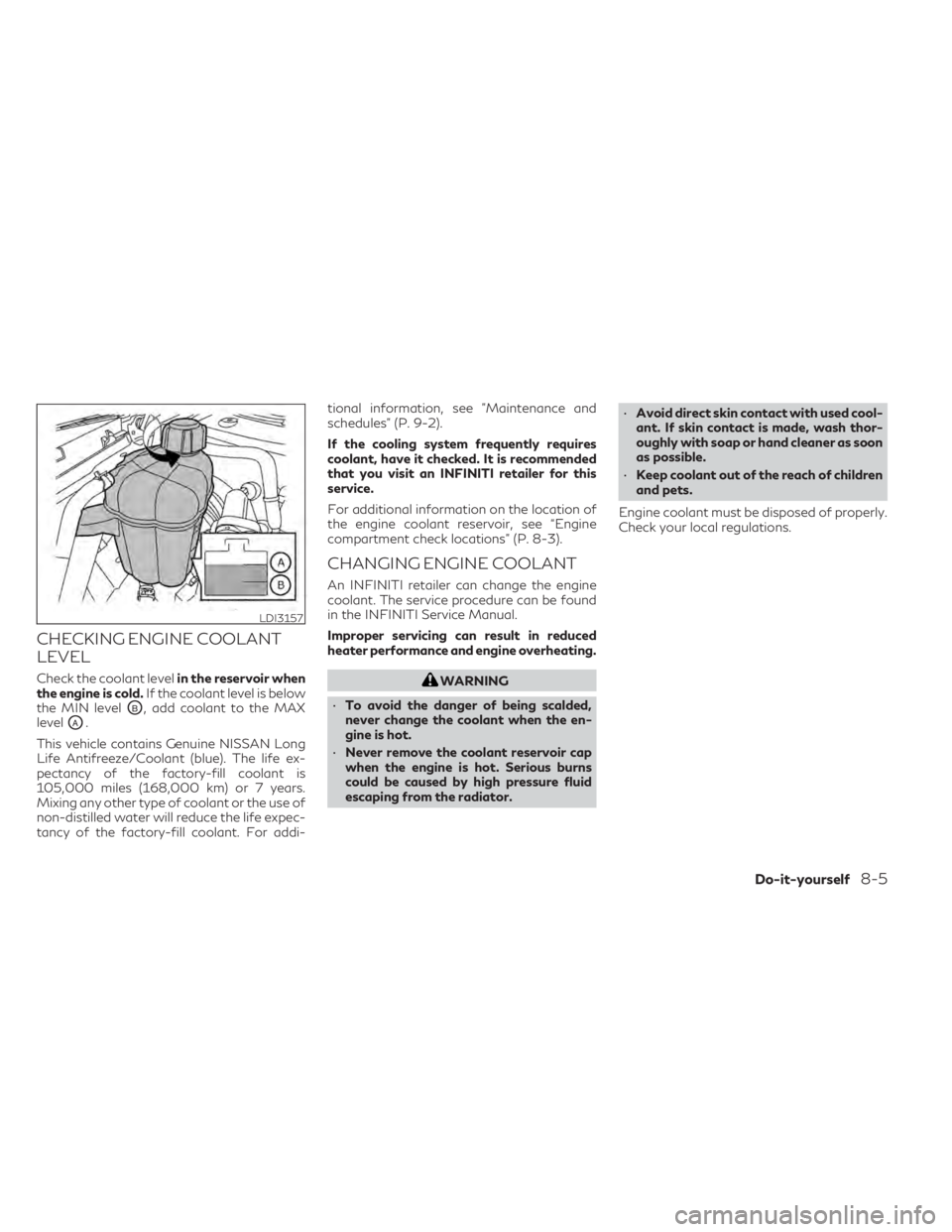
CHECKING ENGINE COOLANT
LEVEL
Check the coolant levelin the reservoir when
the engine is cold. If the coolant level is below
the MIN level
OB, add coolant to the MAX
level
OA.
This vehicle contains Genuine NISSAN Long
Life Antifreeze/Coolant (blue). The life ex-
pectancy of the factory-fill coolant is
105,000 miles (168,000 km) or 7 years.
Mixing any other type of coolant or the use of
non-distilled water will reduce the life expec-
tancy of the factory-fill coolant. For addi- tional information, see "Maintenance and
schedules" (P. 9-2).
If the cooling system frequently requires
coolant, have it checked. It is recommended
that you visit an INFINITI retailer for this
service.
For additional information on the location of
the engine coolant reservoir, see “Engine
compartment check locations” (P. 8-3).
CHANGING ENGINE COOLANT
An INFINITI retailer can change the engine
coolant. The service procedure can be found
in the INFINITI Service Manual.
Improper servicing can result in reduced
heater performance and engine overheating.
WARNING
• To avoid the danger of being scalded,
never change the coolant when the en-
gine is hot.
• Never remove the coolant reservoir cap
when the engine is hot. Serious burns
could be caused by high pressure fluid
escaping from the radiator. •
Avoid direct skin contact with used cool-
ant. If skin contact is made, wash thor-
oughly with soap or hand cleaner as soon
as possible.
• Keep coolant out of the reach of children
and pets.
Engine coolant must be disposed of properly.
Check your local regulations.
LDI3157
Do-it-yourself8-5
Page 445 of 542

1. Automatic tensioner pulley
2. Generator pulley
3. Water pump pulley
4. Air conditioner compressor pulley
5. Crankshaft pulley
WARNING
Be sure the ignition switch is in the OFF or
LOCK position before servicing drive belt.
The engine could rotate unexpectedly. 1. Visually inspect the belt for signs of un-
usual wear, cuts, or fraying. If the belt is in
poor condition, have it replaced. It is rec-
ommended that you visit an INFINITI re-
tailer for this service.
2. Have the belt checked regularly for condition.
REPLACING SPARK PLUGS
Iridium-tipped spark plugs
It is not necessary to replace iridium-tipped
OAspark plugs as frequently as conventional
type spark plugs because they last much lon-
ger. Follow the maintenance log shown in the
"Maintenance and schedules" section of this
manual. Do not service iridium-tipped spark
plugs by cleaning or regapping.
• Always replace spark plugs with recom-
mended or equivalent ones.
WDI0638SDI1895
DRIVE BELT SPARK PLUGS
Do-it-yourself8-15
Page 446 of 542

WARNING
Be sure the engine and ignition switch are
off and that the parking brake is engaged
securely.
CAUTION
Be sure to use the correct socket to remove
the spark plugs. An incorrect socket can
damage the spark plugs.
If replacement is required, it is recommended
that you visit an INFINITI retailer for this
service.
WARNING
• Operating the engine with the air cleaner
filter off can cause you or others to be
burned. The air cleaner filter not only
cleans the intake air, it also stops the
flame if the engine backfires. If the air
cleaner is not installed and the engine
backfires, you could be burned. Never
drive with the air cleaner filter off. Be
cautious working on the engine when the
air cleaner is off. •
Never pour fuel into the throttle body or
attempt to start the engine with the air
cleaner removed. Doing so could result in
serious injury.
To remove the filter from the air cleaner, push
the clips
OAand pull the cover upward.
The viscous paper type filter element should
not be cleaned and reused. Replace it accord-
ing to the maintenance log shown in the
“Maintenance and schedules” section of this
manual.
When replacing the air filter, wipe the inside
of the air cleaner housing and the cover with
a damp cloth.
NOTE:
After installing a new air cleaner filter,
make sure the air cleaner cover is seated
in the housing and latch the clips
OA.
IN-CABIN MICROFILTER
The in-cabin microfilter restricts the entry of
airborne dust and pollen particles and re-
duces some objectionable outside odors. The
filter is located behind the glove box. For
additional information on change intervals,
see "Maintenance and schedules" (P. 9-2).
LDI3165
AIR CLEANER
8-16Do-it-yourself
Page 449 of 542
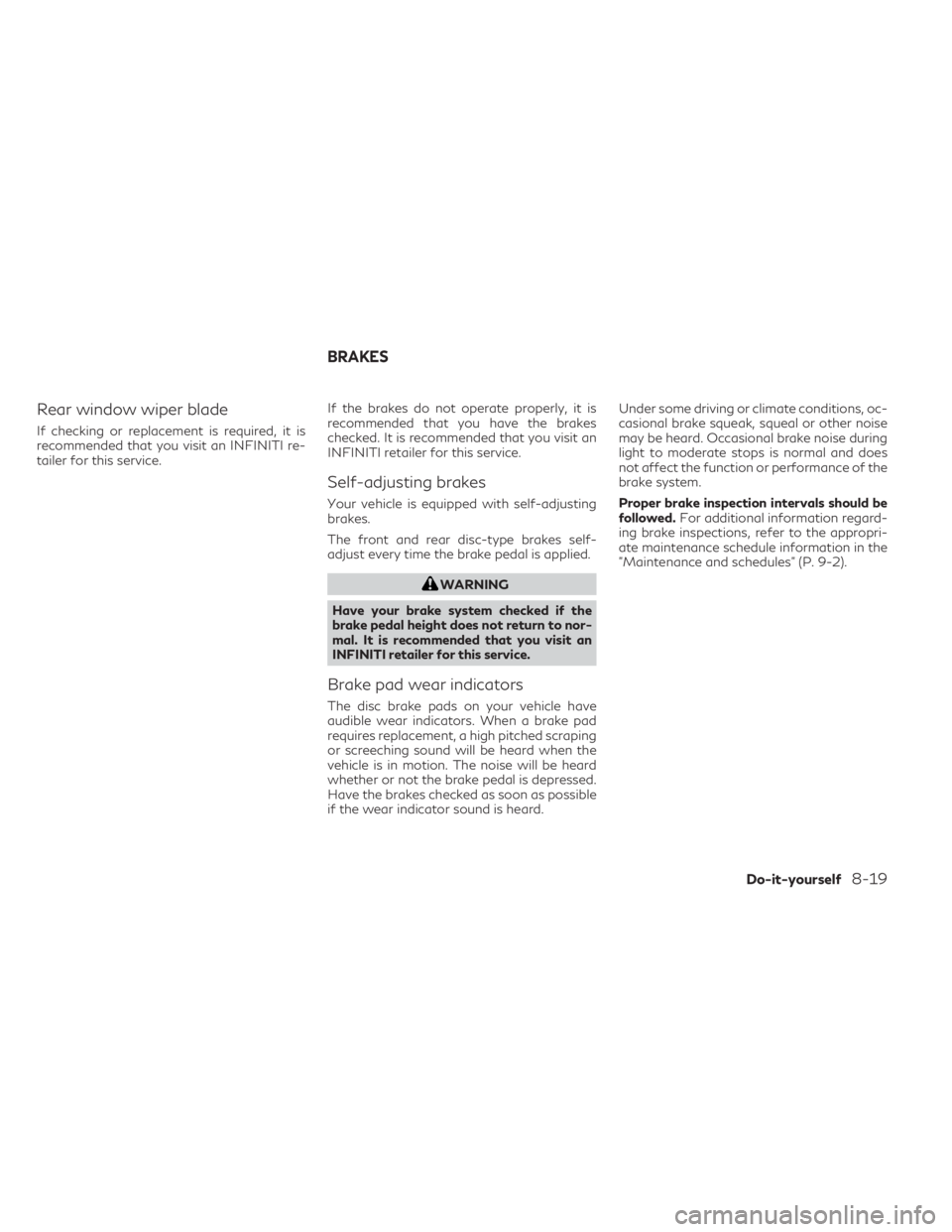
Rear window wiper blade
If checking or replacement is required, it is
recommended that you visit an INFINITI re-
tailer for this service.If the brakes do not operate properly, it is
recommended that you have the brakes
checked. It is recommended that you visit an
INFINITI retailer for this service.
Self-adjusting brakes
Your vehicle is equipped with self-adjusting
brakes.
The front and rear disc-type brakes self-
adjust every time the brake pedal is applied.
WARNING
Have your brake system checked if the
brake pedal height does not return to nor-
mal. It is recommended that you visit an
INFINITI retailer for this service.
Brake pad wear indicators
The disc brake pads on your vehicle have
audible wear indicators. When a brake pad
requires replacement, a high pitched scraping
or screeching sound will be heard when the
vehicle is in motion. The noise will be heard
whether or not the brake pedal is depressed.
Have the brakes checked as soon as possible
if the wear indicator sound is heard. Under some driving or climate conditions, oc-
casional brake squeak, squeal or other noise
may be heard. Occasional brake noise during
light to moderate stops is normal and does
not affect the function or performance of the
brake system.
Proper brake inspection intervals should be
followed.
For additional information regard-
ing brake inspections, refer to the appropri-
ate maintenance schedule information in the
"Maintenance and schedules" (P. 9-2).
BRAKES
Do-it-yourself8-19
Page 471 of 542

9 Maintenance and schedules
Maintenance requirements.......................9-2
General maintenance ..........................9-2
Scheduled maintenance .......................9-2
Where to go for service .......................9-2
General maintenance .............................9-2
Explanation of general maintenance
items .........................................9-2
Explanation of scheduled maintenance items ......9-5Emission control system maintenance:
.........9-6
Chassis and body maintenance: ................9-6
Maintenance schedules ..........................9-7
Additional maintenance Items for severe
operating conditions ..........................9-7
Oil control system .............................9-8
2.0L 4 cylinder
(KR20DDET engine model) ....................9-8